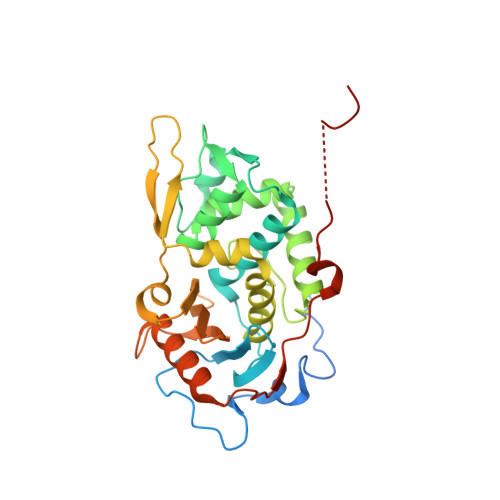Subfamily-specific adaptations in the structures of two penicillin-binding proteins from Mycobacterium tuberculosis.
Prigozhin, D.M., Krieger, I.V., Huizar, J.P., Mavrici, D., Waldo, G.S., Hung, L.W., Sacchettini, J.C., Terwilliger, T.C., Alber, T.(2014) PLoS One 9: e116249-e116249
- PubMed: 25551456
- DOI: https://doi.org/10.1371/journal.pone.0116249
- Primary Citation of Related Structures:
4P0M, 4PPR - PubMed Abstract:
Beta-lactam antibiotics target penicillin-binding proteins including several enzyme classes essential for bacterial cell-wall homeostasis. To better understand the functional and inhibitor-binding specificities of penicillin-binding proteins from the pathogen, Mycobacterium tuberculosis, we carried out structural and phylogenetic analysis of two predicted D,D-carboxypeptidases, Rv2911 and Rv3330. Optimization of Rv2911 for crystallization using directed evolution and the GFP folding reporter method yielded a soluble quadruple mutant. Structures of optimized Rv2911 bound to phenylmethylsulfonyl fluoride and Rv3330 bound to meropenem show that, in contrast to the nonspecific inhibitor, meropenem forms an extended interaction with the enzyme along a conserved surface. Phylogenetic analysis shows that Rv2911 and Rv3330 belong to different clades that emerged in Actinobacteria and are not represented in model organisms such as Escherichia coli and Bacillus subtilis. Clade-specific adaptations allow these enzymes to fulfill distinct physiological roles despite strict conservation of core catalytic residues. The characteristic differences include potential protein-protein interaction surfaces and specificity-determining residues surrounding the catalytic site. Overall, these structural insights lay the groundwork to develop improved beta-lactam therapeutics for tuberculosis.
Organizational Affiliation:
Department of Molecular and Cell Biology and California Institute for Quantitative Biosciences, University of California, Berkeley, California, 94720, United States of America.















